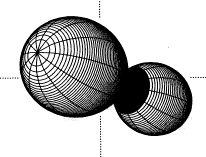 | |||
|
| Home > Public Information > Scientific Highlights > 1990 |
|
in 1990* |
[ STARS | OBSERVATIONAL COSMOLOGY | OTHER ]
|
|
||
| ||
| More
information
ING facilities involved:
|
CATACLYSMIC VARIABLES
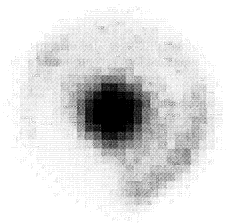 Accretion
disks have aroused much interest in many different fields of astronomy.
When they occur in binary star systems they can be studied particularly
well since they are relatively nearby and bright, and because a reliable
model of the geometry of the system is available. Among the most interesting
type of binary system is the cataclysmic variable, which exhibits a spectacular
variability on a wide range of timescales. This consists of a white dwarf
primary and a cool secondary star. The cool star fills its Roche Lobe and
mass from its outer layers falls towards the white dwarf. Because of its
angular momentum, however, the infalling gas is forced into orbit around
the white dwarf where it is stored in an accretion disk, which is responsible
for a large proportion of the light emitted by the system. In some systems,
the secondary star periodically eclipses parts of the accretion disk, producing
a dip in the light curve typically lasting half an hour. The shape and
colour of the eclipse curve reflects the intensity and temperature structure
of the disk.
Accretion
disks have aroused much interest in many different fields of astronomy.
When they occur in binary star systems they can be studied particularly
well since they are relatively nearby and bright, and because a reliable
model of the geometry of the system is available. Among the most interesting
type of binary system is the cataclysmic variable, which exhibits a spectacular
variability on a wide range of timescales. This consists of a white dwarf
primary and a cool secondary star. The cool star fills its Roche Lobe and
mass from its outer layers falls towards the white dwarf. Because of its
angular momentum, however, the infalling gas is forced into orbit around
the white dwarf where it is stored in an accretion disk, which is responsible
for a large proportion of the light emitted by the system. In some systems,
the secondary star periodically eclipses parts of the accretion disk, producing
a dip in the light curve typically lasting half an hour. The shape and
colour of the eclipse curve reflects the intensity and temperature structure
of the disk.
Using the Multipurpose Fotometer
mounted on the JKT, researchers observed several eclipses of the eclipsing
cataclysmic variable UX Uma in four wavebands and reconstructed the accretion
disk structure using a maximum-entropy technique. The reconstruction shows
that the bulk of the optical radiation comes from a more or less symmetric
structure centered on the white dwarf, but that there is also a smaller
spot, where the gas stream from the cool star hits the accretion disc.
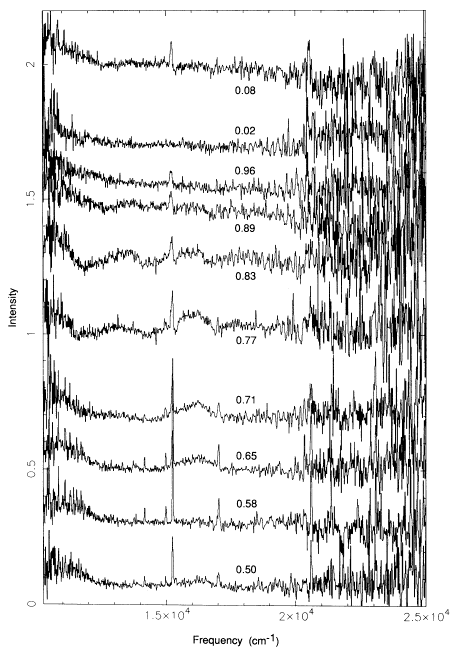 AM
Her systems are an important class of cataclysmic variables in which the
secondary star loses material to a strongly magnetic white dwarf primary.
The magnetic field on the primary is enormously strong, some tens of megagauss,
so that the stream of material does not form a disk, but is captured by
the field, and accretes on to the white dwarf in one or more shock regions
at the magnetic poles. The energy of the system is released partly as X-rays
in the shocks, and partly as optical cyclotron radiation from free electrons
in the stream spiralling in the magnetic field. This radiation is emitted
at low-order harmonics of the fundamental cyclotron frequency, broadened
into humps by Doppler motion of the electrons in the emission region. Observing
these humps in the spectra of AM Her systems is very difficult, but some
reseachers using the WHT Faint Object Spectrograph were able to detect
humps in a total of five systems. From the observations it is possible
to determine the magnetic field strengths and temperatures of the emitting
regions. The fields lie between 25 and 44 megagauss and the estimated temperatures
lie between 5.0 and 23 keV. The data are now subject to detailed modelling.
AM
Her systems are an important class of cataclysmic variables in which the
secondary star loses material to a strongly magnetic white dwarf primary.
The magnetic field on the primary is enormously strong, some tens of megagauss,
so that the stream of material does not form a disk, but is captured by
the field, and accretes on to the white dwarf in one or more shock regions
at the magnetic poles. The energy of the system is released partly as X-rays
in the shocks, and partly as optical cyclotron radiation from free electrons
in the stream spiralling in the magnetic field. This radiation is emitted
at low-order harmonics of the fundamental cyclotron frequency, broadened
into humps by Doppler motion of the electrons in the emission region. Observing
these humps in the spectra of AM Her systems is very difficult, but some
reseachers using the WHT Faint Object Spectrograph were able to detect
humps in a total of five systems. From the observations it is possible
to determine the magnetic field strengths and temperatures of the emitting
regions. The fields lie between 25 and 44 megagauss and the estimated temperatures
lie between 5.0 and 23 keV. The data are now subject to detailed modelling.
| More
information
ING facilities involved:
|
PROBLEMS FOR COLD DARK MATTER AND
THE 'GREAT ATTRACTOR'
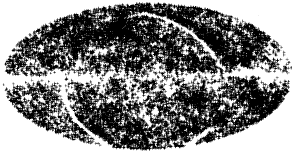 Bright
hight redshift quasars are important observation probes of the structure,
evolution and early history of the Universe. The mere existence of the
most luminous high-redshift quasars poses problems for currently popular
models of the Universe, for example Cold Dark Matter, because the time
available to form such massive energy sources since the Big Bang is uncomfortably
short: only 1 billion years at a redshift of z=4. Their high optical luminosity
means that they can be easily studied over very large cosmological distances,
and they are particularly valuable as probes of the intervening gas clouds
and galaxies, and for such fundamental investigations as the temperature
of the microwave background, deuterium abundance and the large scale structure
at early epochs.
Bright
hight redshift quasars are important observation probes of the structure,
evolution and early history of the Universe. The mere existence of the
most luminous high-redshift quasars poses problems for currently popular
models of the Universe, for example Cold Dark Matter, because the time
available to form such massive energy sources since the Big Bang is uncomfortably
short: only 1 billion years at a redshift of z=4. Their high optical luminosity
means that they can be easily studied over very large cosmological distances,
and they are particularly valuable as probes of the intervening gas clouds
and galaxies, and for such fundamental investigations as the temperature
of the microwave background, deuterium abundance and the large scale structure
at early epochs.
There are now 20 quasars known above a redshift of z=4, seven of which have had their nature and redshift confirmed using the INT. One third of the 36 highest known redshift quasars have been discovered by the ING.
Further problems with the Cold Dark Matter model were revealed in an analysis of large-scale galaxy clustering published recently. The researchers undertook an all-sky redshift survey of IRAS galaxies: 1211 new redshifts were obtained, the great majority with the WHT, with some from the INT and other telescopes. Other redshifts were obtained from the literarure or unpublished sources. The result was a uniform all-sky sample encompassing a larger volume of the Universe than any previous redshift survey and a map of the distribution of galaxies within a radius of 150h-1 Mpc. A clustering analysis of this map showed that the variation in density of galaxies over the Universe is inconsistent with the predictions of the Cold Dark Matter model.
The same reseachers used the map
of the distibution of galaxies on the Local Group of Galaxies, and deduce
the corresponding perculiar motion of the Local Group. They found that
the acceleration acting on the Local Group is generated by a dozen or so
clusters within 100h-1Mpc, and the velocity of the Local Group
with respect to the microwave background radiation of 600 kms-1
can be explained provided the Universe has a density close to the critical
value. No additional clusters located behind the galactic plane are needed
to account for the Local Group motion, and there is no very large structure
behind the Centaurus cluster capable of generating the claimed streaming
motions of 1000kms-1, so the rationale for the 'Great Attractor'
appears to have faded.
| More
information
ING facilities involved:
|
GRAVITATIONAL LENSING
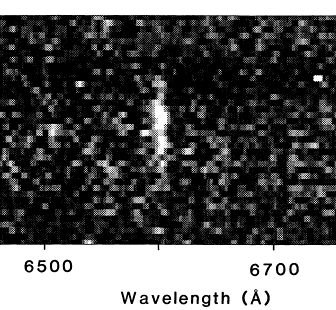 Gravitational
lensing, the reimaging of a distant object by a massive intervening one,
is a prediction of General Relativity which has only recently been observationally
confirmed. Astronomers are seeking to use this phenomenon constructively
to learn about the Universe. The most promising lenses are moderate redshift
clusters of galaxies whose gravitational potential produces distorted arc-like
images of remote background galaxies. The technique promises to reveal
details of the high redshift universe unobtainable by conventional observations.
One of the most challenging arc redshift determinations was achieved using
ISIS on the WHT.
Gravitational
lensing, the reimaging of a distant object by a massive intervening one,
is a prediction of General Relativity which has only recently been observationally
confirmed. Astronomers are seeking to use this phenomenon constructively
to learn about the Universe. The most promising lenses are moderate redshift
clusters of galaxies whose gravitational potential produces distorted arc-like
images of remote background galaxies. The technique promises to reveal
details of the high redshift universe unobtainable by conventional observations.
One of the most challenging arc redshift determinations was achieved using
ISIS on the WHT.
An exposure lasting over three
hours was made of an extremely faint arc structure around the central galaxy
of the rich cluster Abell 963 (redshift z=0.206) in 0.8 arcsecond seeing,
revealing a single strong emission line at a wavelength of 6600Å.
The interpretation of this observation is that the imaged object is a very
distant spiral galaxy containing regions of active star formation: the
emission line is [OII] redshifted to z=0.771. A second arc in this cluster
proved too faint for spectroscopy, but INT images showed that the two arcs
have similar unusually blue colours, indicating that they are two gravitational
images of the same object.
| More
information
ING facilities involved:
|

